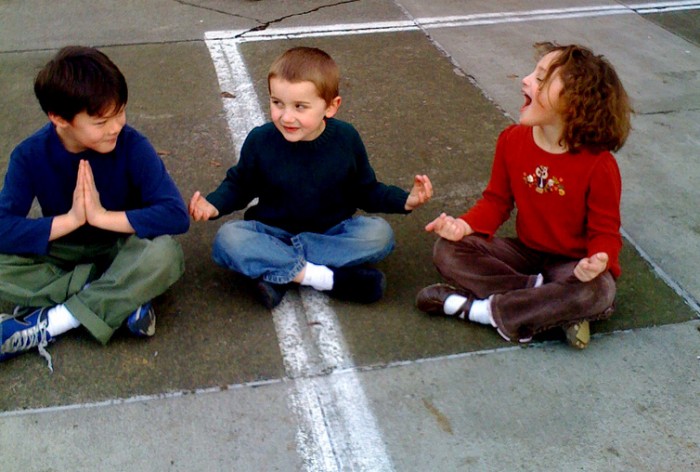
Meditation is simple for children to learn, as they are open-minded, inquisitive and very receptive. Not only does it improve their overall health and wellbeing it also increases their attention span so they will perform better in all of their daily activities. Meditating at bedtime also helps to soothe and calm the mind so that they can achieve a deeper, less restless sleep.
Even though standard meditation is easy to learn, creative methods can be introduced for children, or even adults, to make it more fun and appealing.
The best part about guiding children through meditation is that because they naturally live in the present moment we can learn as much from them, if not more, about mindfulness as they can learn from us. We should never underestimate the wisdom and capabilities of a child!
Not only that, children’s high vibrational energy due to their ability to love unconditionally, accept easily and forgive quickly, means that being in their company brings on a deep sense of inner peace and brings us back to our innocent ego-less self.
Although it is much better to have someone qualified and authorized to teach meditation, parents, grandparents, teachers or any caregiver can guide children through the steps. Ideally, meditation would be taught in all schools at the start of every day so that the children have the opportunity to be grounded, balanced and calm before their classes begin.
Begin the meditation by asking the child to relax and sit comfortably, whether on a cushion on the floor or on a chair, and then introduce a breathing exercise.
Children can become quite fascinated when paying attention to breathing and quite often for younger children this may be the first time they will be noticing that they can consciously focus on their breath, as many do it without any awareness.
When they inhale you can ask the child to put their hands on their belly and watch how it expands like a balloon and then as they exhale they can notice how their hands move inwards with their belly as the air leaves the lungs. Children are amazed at the immediate effects breathing has on their body and mind, especially when they watch and feel how their body responds to deep inhalations and exhalations.
Breathing exercises are also extremely useful to introduce whenever the child feels overwhelmed or is feeling the urge to cry. Although tears can be cleansing and should not be discouraged, breathing is a way to channel any pent up energy so that the child feels as though they have control over their impulses, rather than the other way around. As the child breathes in they can imagine inhaling love and happiness and on the exhalation breathing out anything upsetting or any sadness they may have been experiencing.
Stretching exercises will help children start their day energized and they can be done at a slower, calmer pace at sleep time to help the child unwind and physically prepare the body for rest. Ask the child to imagine a seed growing up and outwards and encourage them to think about it developing into a beautiful, colorful plant. Then, either go through the motions and ask the child to watch and then copy, or they can be adventurous and enact how they imagine a plant to grow and you can copy. Start off small, curled into a ball, with the hands touching both feet to represent being grounded into the earth and then start to slowly unfurl and straighten the knees and then the body, spreading the arms out far to each side and then up towards the sky and back down towards the thighs.
This simple exercise can be repeated as many times as the child’s interest is captured, or you can suggest performing it seven times and each time the flower blooms, they can imagine their hands and arms as the petals turning into one of the vibrant colors of the rainbow. If the child is aware of colors you can ask the child how the colors make them feel or how their emotions or experiences connect with each color.
Singing or chanting any word or rhyme that the child has a positive association with, is a way to use the power of vibration to release any anxiety and to enhance emotional or psychological healing. When we vocalize a word we also alter the energy in our body. OM is the sound of the universe and children of all ages can find the word intriguing, especially when they experiment with it by saying it in various tones of voice, for different lengths of time or also when others join in to create a harmonious melody. The child can choose any word, or few words, they feel a connection with, then they can decide how they prefer to vocally express the word/s. The child can go solo, or follow suit and either keep to their rhythm by first asking the child to pick a few words for you and then mix them in to create a mini song.
Visualization is a brilliant tool to help keep a child’s interest sustained. Before meditating ask the child to conjure up magical images in their mind. Once they have communicated those things, you can then invent a story to allow their imagination to run wild while softly talking them through the meditation. As you narrate the story, regularly and gently remind the child to focus on their breathing so that they remain centered and alert while mentally exploring mystical far away places.
The difference between a visual meditation and a bedtime story is that the child can become more actively engaged in the visualization. This is because firstly the child has chosen the outline for the scenario, and also because the story has been personalized to appeal to them. The child can join in and suggest new characters, places or objects that they want involved in the meditation or they can even take the lead and describe the visualization themselves while keeping their eyes closed, if comfortable, and being quietly prompted to breath deeply while doing so.
Visual meditations help the child to let go of any persistent thoughts that may have been running amok in their minds and this encourages them to concentrate more intently on the meditation. The best thing about visualizations is that they also enhance creative abilities and the child may naturally become accustomed to tapping into their mind to invent alternative scenarios. Learning how to alter perception by creating new realities will assist the child whenever they are faced with problem solving, as they discover how to effectively use their imagination to evoke a limitless array of possibilities.
As the child progresses, it is beneficial to encourage them to identify their persistent thoughts or existing emotions. Many of the troubles that adults are faced with are due to them not having had the ability to reason or rationalize during childhood. It can seem to an adult as though children have little to deal with on a daily basis, however, even the smallest ordeals can be complex and challenging to navigate and overcome. As their meditation practice develops, their awareness and insight significantly increases too.
When children are able to gain an understanding of how they are feeling and particularly, why they are feeling a specific way, they will then be able to process their thoughts and emotions in a way that enables them to become emotionally intelligent. This allows them to work out how to let go of their feelings so that they flow freely, rather than holding on and harboring sensations that result in consistent triggers or emotional behavioral patterns repeating. Even if the child is not yet able to clearly recognize their thoughts or emotions in order to discern them, just by observing and becoming more aware of them will alleviate patterns of attachment so that they disperse with the assistance of deep breaths to release any tension they may be causing.
Asking the child to pull up a thought or emotion and then suggesting that they can decide to softly blow it away if they want to, similarly to how they would blow on a dandelion flower, can help them to make sense of this therapeutic process.
It is important to make it clear to the child that there is no right or wrong way to meditate and that it is something for them to enjoy and play around with. Anything that allows a child to settle their mind, concentrate on breathing while remaining relaxed will work wonders, whether it takes place for two minutes or two hours.
Some children may fidget and want to move around and be physically active while others may manage to stay still and quiet for the duration. Every child is unique and so will each meditation session be, and the intention for the practice is progression and not perfection.
Start slowly with no expectations or pressure at all and soon it can become something the child looks forward to and eventually progresses to be able to do it entirely on their own, wherever or whenever they choose to.
Meditation is particularly beneficial when a child feels distressed or anxious as it empowers them to take a few minutes for themselves so that they can regain control emotionally, physiologically and mentally and ultimately feel safe, relaxed, focused and with a profound sense of inner peace.
~
Author: Alex Myles
Editor: Travis May
Photo: Flickr/Todd Fahrner











Read 1 comment and reply